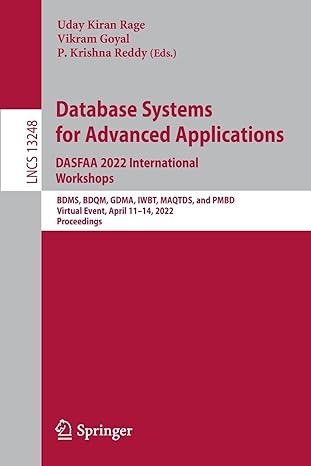Question
Part IV. Application to Markov Chains In this exercise, you will work with Markov Chains. Please read the theoretical part and perform the tasks presented
Part IV. Application to Markov Chains
In this exercise, you will work with Markov Chains. Please read the theoretical part and perform the tasks presented below.
Theory: A vector with nonnegative entries that add up to 1 is called a probability vector. A stochastic matrix is a square matrix whose columns are probability vectors (this corresponds to the definition of a left-stochastic matrix in an early project). A Markov chain is a sequence of probability vectors , together with a stochastic matrix P, such that,
.
In other words, a Markov chain is described by the first-order difference equation for
The n entries of a vector list, respectively, a probability that the system is in one of the n possible states. For this reason, is called a state vector.
If P is a stochastic matrix, then a steady-state vector for P is a probability vector q such that .
A stochastic matrix P is called regular if some matrix power contains only strictly positive entries.
Theorem: If P is an regular stochastic matrix, then P has a unique steady-state vector q. Further, if is any initial state and for , then the Markov chain converges to q as .
Note: The steady-state vector describes the state of the dynamical system in a long run, and the initial state has no effect on the long-term behavior of the Markov chain.
(Read more on Markov Chains in the textbook: Section 4.9, Applications to Markov Chains.)
Exercise 6 (4 points) Difficulty: Moderate
**Create a function in MATLAB
function q = ststate(P,x0)
[~,n]=size(P);
S=sum(P);
The function has to perform the following tasks:
** Check if the given matrix P is stochastic by using closetozeroroundoff(S-ones(1,n)).
If P is not stochastic, the outputs are:
disp('Error: P is not stochastic')
q=[];
If P is stochastic, do the following:
**Find the steady-state vector q. Recall: the steady-state vector is the probability vector which is a solution of , or, equivalently, . A rational basis for the solution set of this system, which should contain here only one vector, can be found by
Q = null(P-eye(n),'r');
To get the unique (probability) vector q, you need to scale the vector , that is, , where (the sum of the entries of the column vector ).
**Verify that the Markov chain converges to q by calculating consecutive.
until, for the first time,
**Output xk and the number of iterations k.
Note on the form of the outputs:
You can compute xk by using while loop: initialize x1 and k, use the formula x1=P*x0, set up while loop, and reassign x0=x1 after each iteration. Doing it this way, you will need to output (which will be your xk after the loop terminates) and the number of iterations k (which you can find by setting a counter within the loop).
Please make sure that you suppress all intermediate iteration!
**Type the function ststate in your diary file.
**Run the function q = ststate(P,x0)on the following matrices P and vectors x0:
(a) P=[.3 .3;.5 .7], x0=[.4;.6]
(b) P=[.5 .3;.5 .7] and x0=[.4;.6] is the same as in part (a).
(c) P=[.9 .2;.1 .8] is a migration matrix between two regions and the initial vectors are:
x0=[.12;.88], x0=[.14;.86], and x0=[.86;.14]
% Compare the output vectors q in part (c) for different initial vectors and comment whether the initial vector has an impact on the steady-state vector q. What about the number of iterations k?
(d) Car rental pick-up/return matrix between the Airport, Downtown, and Metro, and
P=[.90 .60 .30; .05 .30 .40;.05 .10 .30], x0=[.6;.3;.1]
(e) The vector x0 is the same as in (d), but
P=[.90 .60 .30; .06 .30 .40;.05 .10 .30]
**Close out the diary file.
Step by Step Solution
There are 3 Steps involved in it
Step: 1

Get Instant Access to Expert-Tailored Solutions
See step-by-step solutions with expert insights and AI powered tools for academic success
Step: 2

Step: 3

Ace Your Homework with AI
Get the answers you need in no time with our AI-driven, step-by-step assistance
Get Started


